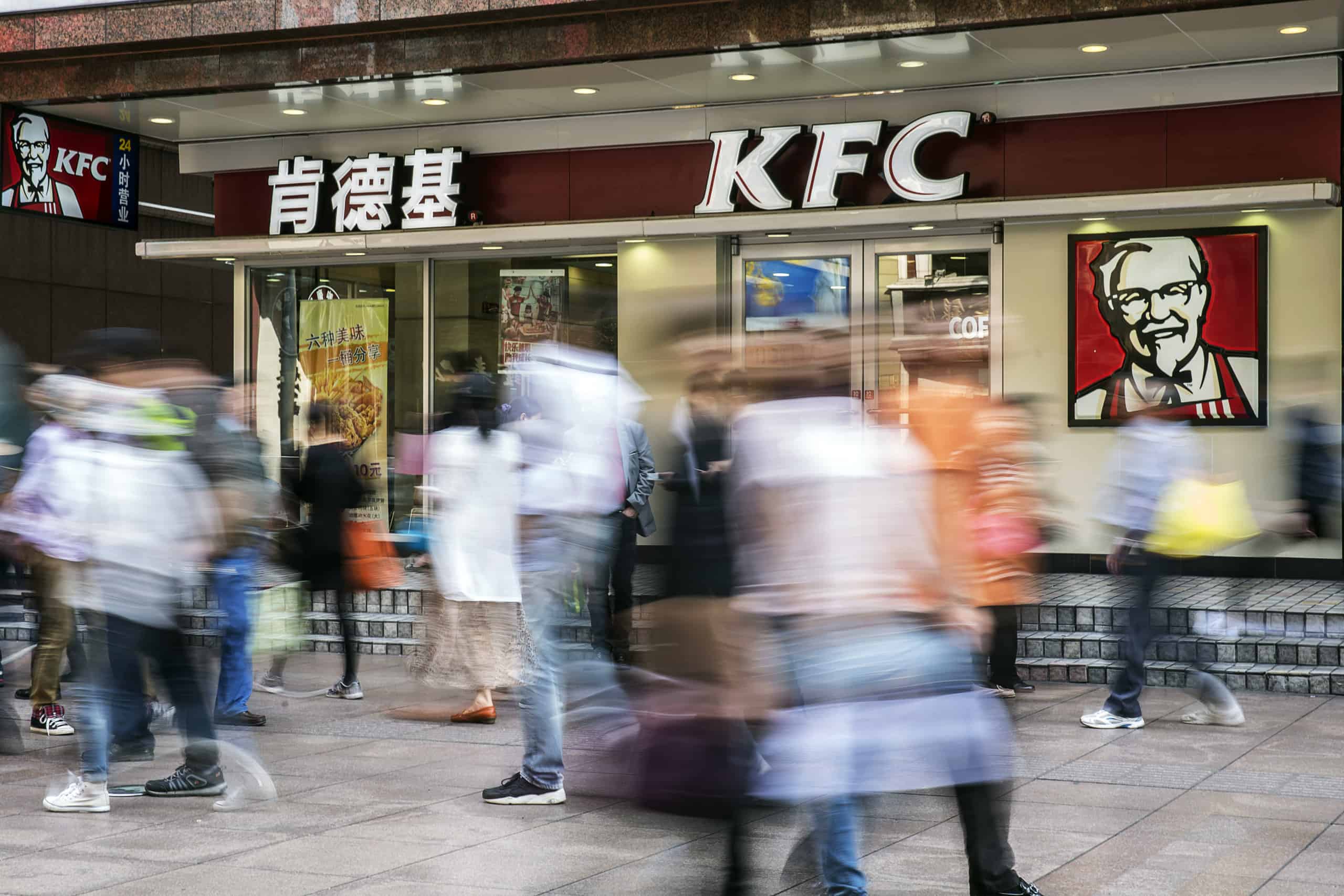
Credit: Qilai Shen/Bloomberg via Getty Images
Listen to SupChina editor-at-large and Sinica podcast host Kaiser Kuo read this article.
In October 2015, Greg Creed had his back against a wall. The bespectacled Aussie was chief executive of Yum Brands, the U.S. fast food restaurant giant, and the company’s sluggish growth had turned its quarterly earnings call into something close to a day of reckoning. Earnings for the previous quarter and projections for the rest of the year were well below analyst expectations and quarterly sales at the company’s eateries, which include KFC, Pizza Hut, and Taco Bell, were up a mere 2 percent.
For Kentucky-based Yum, much of the trouble originated from an unlikely place: China, long the crown-jewel of its quick-service empire. Decades ago, KFC had been the first Western fast-food restaurant to open its doors in the country, and the chain’s red-and-white chicken buckets had become familiar sights everywhere from Beijing to Kunming. But food safety scandals and fresh competition from mom-and-pop stores, Chinese chains and other foreign eateries meant that Yum’s dominance in a critical market was slipping away.
A transcript of the call shows that Creed admitted Yum had stumbled during what he described as “a savage battle for supremacy” on once familiar turf, but — in between being pummeled by questions on the call — he floated a colossal number as an enticement for patience: “We’ve still got growth in China that’s still greater than it is in most of the markets we operate. We do believe that the consuming class will go from about 300 million people to 600 million people by 2020.”
His audience wasn’t buying it. Even before the call, Keith Meister, the brash founder of Corvex Capital Management and an activist investor who had acquired a stake in Yum earlier that year, had been advocating, with others, a solution to the China problem. Rather than directly manage thousands of KFC and Pizza Hut restaurants on the other side of the world, they said, the company could transfer assets to a new China-based company that would own and operate just about everything there, and pay the parent company what would amount to a massive franchise fee.
Creed and other Yum executives pushed back, pointing out that critics were “highlighting a short-term perspective and a long-term perspective, and we’ve always taken a long-term perspective on our business.” Nevertheless, the short term had the final say: within hours, the share price tumbled more than 19 percent and within a year, there were two Yums in two giant markets. Neither Yum executives nor Creed, who retired in 2019, agreed to be interviewed for this article.
Today, it’s all about building the Chinese version of who you are. You can keep your DNA, but you can’t try to export your American product or brand.
Michael Zakkour, founder of 5 New Digital consulting
Today, Yum Brands operates in the United States and elsewhere around the world, while Yum China Holdings, backed initially by Chinese money and with a leadership team experienced in KFC China operations, hawks the best southern-fried chicken in Beijing. Yum Brands, meanwhile, earns hundreds of millions of dollars in annual licensing fees, equal to 3 percent of net system sales in China. The idea of a spinoff was similar to what Imax, the immersive cinema company, engineered in 2010 when it established Imax China with a revenue sharing agreement. And it offered a possible reality check for U.S. companies with their own large China operations.
“It’s a much more profitable way to run a business when the company that’s owning the brand isn’t building the restaurant, finding the real estate, and hiring the workers, and so on,” says Michael Schaefer, head of food and beverage research at Euromonitor.
Indeed, more than five years later, both Yums have prospered. Yum Brands books as much as $200 million a year in fees from China alone and, in a February 2020 earnings call — before the coronavirus spread — the company said it eclipsed $50 billion in system sales in 2019 and opened its 50,000th restaurant worldwide.
Although Creed lost his argument in 2015, his assessment of the potential for growth in China was spot on. Yum China has bested its American parent in notable ways. Now listed in New York and Hong Kong, the company has more than doubled in value. With a market capitalization of $26 billion, Yum China ranks fifth in the world in the quick service food market industry — right behind Yum Brands.
It’s hard to imagine that this magnitude of growth would have happened without the split. Yum China, infused with local talent, bears little resemblance to its American ancestor. With apps that harness customer enthusiasm and build allegiance through convenience, Yum China is known as agile and creative — traits its Chinese chief executive, Joey Wat, has prioritized since taking charge in 2018.

Credit: Yum China
Wat, who headed KFC China after working at McKinsey, experimented with Yum China even during the pandemic. As diners huddled in their homes, she added noodle dishes, meal kits and even bubble tea to its takeaway menu. According to Yum China’s latest earnings report, revenue grew 11 percent to almost $2.3 billion, and home delivery and takeout accounted for 50 percent of sales. “In a highly competitive market, and very fast-changing market like China, we truly believe that innovation is the key not only to survival but to success,” Wat recently told CNN.
The story of the Yum split, then, is one of a corporate “conscious uncoupling” — with both companies coming out stronger. Sure, Yum Brands isn’t earning the billions in China that its executives once enjoyed, but its investors opted for a durable bargain: the company reaps a dependable fortune without trying to manage a Chinese market that is spirited but challenging. Given the transformation in China in recent years, it’s a choice, analysts say, that other brands will study.
“Today, it’s all about building the Chinese version of who you are,” says Michael Zakkour, founder of 5 New Digital consulting. “You can keep your DNA, but you can’t try to export your American product or brand.”
PEKING CHICKEN
The first KFC — then known as Kentucky Fried Chicken — opened in Beijing on Nov. 12, 1987, a short distance from Mao Zedong’s mausoleum. It was a sensation. Thousands of people lined up in the autumn cold to enter the three-story restaurant which, at nearly 12,000 square feet, was large enough to accommodate 500 customers and 150 employees.1See The Washington Post account here and this report that published by MacroPolo The launch included a ceremony featuring then-U.S. Ambassador Winston Lord and Beijing Vice Mayor Sun Fuling. An actor dressed in a chicken costume entertained the crowds, and people posed for photos next to a life-sized statue of Colonel Sanders. The restaurant’s American origins were explicit. A dispatch from UPI noted the large photos of the Manhattan skyline and the Statue of Liberty on its walls, and a poster saying “catch the American spirit!” But amid the exuberance, one Chinese official attending pronounced a distinct lack of enthusiasm for the deep-fried fare. “I don’t see this as competing with Peking duck,” he said.
Historical footage shows the opening of China’s first KFC in 1987.
It soon became apparent that the food was almost beside the point. KFC offered China an entirely new concept of what a restaurant could be. In Beijing, dining out was often a dismal experience, wrote anthropologist Yunxiang Yan in The Consumer Revolution in Urban China, with restaurants characterized by a “poor maintenance of internal space, a limited choice of foods… and, of course, ill-tempered workers who acted as if they were distributing food to hungry beggars instead of paying customers.”
KFC, by contrast, offered air-conditioned and bright establishments, friendly staff, and instructions for customers to politely queue for food. Unable to compete on price — cheap delicious street food is prevalent in China — KFC instead marketed itself as a destination for the country’s budding middle class. Young professionals began to treat KFC restaurants as places for romantic dates or to impress business clients used to more traditional, alcohol-soaked work banquets. Beijingers even booked the upper room at the first KFC for wedding receptions. As restaurants expanded, some set aside rooms for children’s parties and staff led singalongs.
From the beginning, KFC pursued a different strategy from McDonald’s, its chief competitor, which arrived three years later. It had some inherent advantages. Fried chicken was a more familiar food to Chinese consumers than hamburgers, and KFC’s buckets were conducive to the communal style of eating in China. KFC localized its menus, adding egg tarts, fried dough sticks and rice porridge. McDonald’s too would try to adapt, adding a taro pie to its menu in 2005. But in that first decade KFC secured a reputation for catering to its customers’ tastes rather than relying on the allure of its brand. Warren Liu, who wrote KFC in China: Secret Recipe of Success as an insider chronicle of the early years, observed “when McDonald’s introduces new products, they are often perceived by Chinese consumers as less local than those from KFC.”
KFC and its corporate sibling Pizza Hut expanded rapidly across the country. It opened restaurants in second and third-tier cities, places largely unknown to anyone outside China but with upwardly mobile populations. Soon, Chinese-owned copycats opened fried chicken restaurants, undercutting KFC on price, but they could not compete with Yum’s hierarchical management, reliable supply chains, and a perception that foreign products were just better.

Year by year, Yum Brands profit in China grew, by 17 percent in 2008 and another 24 percent in 2009. In its 2010 annual report,2 Profits grew that year by 26 percent. then-CEO David Novak wrote: “Our foundation has never been stronger, and we’re just on the ground floor of growth in China… some of our investors have asked ‘Is Yum too China dependent?’ We believe the answer is, definitively, NO!”
Yum would soon have a different response. In 2012, a segment on Chinese television accused the Su Hai Group, one of Yum’s suppliers, of feeding toxic chemicals to their chickens to hasten growth. Yum denied the allegations but sales fell. The company had to revise earnings projection downward, and the share price tumbled. Informal polls on Sina and Weibo, two Chinese web portals, found that some young consumers were urging a boycott of the restaurants.
Two years later, Yum was again battered. Reporters from Chinese television went undercover at a processing plant owned by OSI, an American company that supplied meat to Yum, McDonald’s, and other foreign companies. Line workers were seen scooping piles of chopped meat from the floor and flipping it onto the processing line. Food packages were reportedly mislabeled to extend expiration dates. Yum noted that only a few menu items were vulnerable to the quality breach, but the blowback was fierce. Young customers railed sarcastically on social media. “I was buying a sandwich at KFC and the cashier said to me, ‘Sir, your coupon has expired. You can’t use it,’ ” quipped someone on Sina Weibo, China’s Twitter. “ ‘Oh,’ I replied, ‘so you know that you can’t use things that are expired?’” Same-store sales in the third quarter dropped 14 percent.
Chinese consumers have been to Italy and have tasted Italian food. They’ve been to France. They love Japanese and Korean food. We had to be more sophisticated.
Jane Gannaway, a former Yum vice president
“When Yum first came to China, news cycles were measured in days,” says David Wolf, a public relations professional who for years lived in Asia. Yum did not realize how swiftly its image could be shredded by online outrage in a distant time zone. “That became an issue for them,” he says, “not just because of the distance from Kentucky but simply because they didn’t have an operation internally in China capable of reacting quickly.”
Jane Gannaway, a former Yum vice president who lived in China for 10 years, saw another dynamic at play. The Chinese palate was increasingly demanding: people wanted regional food and they wanted adventurous combinations. “Chinese consumers have been to Italy and have tasted Italian food. They’ve been to France. They love Japanese and Korean food. We had to be more sophisticated,” Gannaway says.
Yum still dominated in China, but by 2015, China was dominating Yum’s bottom line: It comprised more than half of Yum’s global revenue and a significant percentage of its restaurants. And while the company had other concerns, such as the underperformance of Pizza Hut, the volatility of its China operation raised questions about Yum’s future. The China operation was no longer seen as a bounty but a burden.
“At some point, I wonder when the board and the management team believes that the China turnaround story no longer makes sense to completely dominate the investment conversation for Yum Brands,” Brian Bittner, a managing director at Oppenheimer & Co., said during that uncomfortable earnings call. “I mean, you are basically getting no credit for having the China business in your portfolio today.”
BUCKETS OF PROFITS
If anyone can understand the changing appetites of Chinese consumers, it is Joey Wat. The energetic Yum China CEO was born in Fujian, a coastal province in southeast China; she was delivered by her great-grandmother, a woman with bound feet who served as a local midwife. Wat has told interviewers that she grew up poor, making plastic flowers in a factory at age 9 and working as a waitress in her first restaurant at 15.

Credit: Yum China
Astonishingly — although not entirely uncommon considering the changes that have occurred in China over the past generation — Wat, born in 1971, eventually graduated from Hong Kong University, made her way to Northwestern’s Kellogg School of Management and later worked for McKinsey. By 2014, she joined KFC as its president and CEO. Four years later, she was reshaping Yum China, overseeing a workforce of 400,000.
Wat’s emphasis on digital change has made data a key ingredient to Yum China’s operations. She recently told Time magazine that, by late 2020, digital payments accounted for 97 percent of its business, and KFC and Pizza Hut had about 300 million people enrolled in a digital rewards program, providing appetite preferences with every order. KFC and Pizza Hut’s apps also feature music and games — entertainment that gives Yum enormous insight to what buyers like. Fast Company pointed to the apps when naming Yum China one of the world’s most innovative companies in 2020.
Wat has elevated women to senior positions and she speaks comfortably of her role as a mother. She shuns late-night business dinners. “I don’t play golf, and I don’t feel like I have to apologize for it,” Wat said in 2019 at a Bloomberg Invest Asia Summit in Hong Kong.
While Wat is credited for making the company nimble and agile, Yum China had early and smart help. In 2016, months before the spinoff became official, Primavera, a major Chinese private equity firm, and Ant Financial, whose Alipay digital payment system powers a significant chunk of Yum transactions, invested a combined $460 million in Yum China. Fred Hu, a former Goldman Sachs executive, became a non-executive chairman of the board. In 2018, Yum China attracted a buyout offer from a consortium led by Hillhouse Capital — including China Investment Corp., Beijing’s sovereign wealth fund — that valued the company at $17 billion. Yum China rejected the bid. Two and a half years later, Yum China’s market capitalization has grown more than 50 percent.

There are few naysayers about the wisdom of the Yum spinoff. Other corporations have since reconsidered their operations in a country where custom and government constraints can be vexing. BlackRock divested some retail shopping centers in 2016, and Coca-Cola announced plans to unload its China bottling business in the same year. In 2018, McDonald’s sold a majority stake in its China business to Citic, a huge state-owned conglomerate with extensive financial and real-estate holdings. The structure of the deal didn’t precisely mirror the Yum spinoff but the logic was the same: overseeing the China business from afar had simply become too difficult. “McDonald’s always had this approach: ‘we’re going to fly in our burgers, we’re going to fly in our buns, we’re going to fly in our fries’,” says Gannaway, the former Yum Brands vice president. “That made it hard for them to achieve local relevance.”
In 2019, the year before Covid-19 upended the global economy, the two Yums were energized: Yum Brands registered systems sales growth of 10 percent and same-stores sales growth of 2 percent — numbers nearly matching that of its China upstart. In an interview that year, Greg Creed recalled how cutting loose the fastest growing part of Yum had seemed counterintuitive internally. “A transformation like that, it’s kind of like a scorched-earth policy for the organization,” Creed said. But increasingly, Yum Brands watched Yum China’s experimentation with interest.
In 2019, inspired by what Yum China had done in Shanghai, Yum Brands launched a digital innovation lab to dig deeper into and react faster to customer preferences. A year later, both Yums were able to adjust to the pandemic when in-dining was suspended in their markets.
In the United States, Yum Brands CEO David Gibbs told investors this month that 2020, while challenging, was a “digital sales high note, hitting a record of $17 billion, about a 45 percent increase over the prior year.” About 35,000 restaurants in Yum markets were offering delivery, a 16 percent increase in a year. Pizza Hut was able to pivot and create a contactless curbside pickup program in two weeks. In India, customers can now order KFC delivery through Amazon’s Alexa. Yum China innovated throughout 2020 and even opened new stores. Wat noted the pace, with a bit of flourish, in her earnings call: “We opened 1,165 new stores in 2020, marking the highest new store openings in the 33-year history of operating in China.”
Gannaway, the former Yum engineering head, says the Chinese Yum crowd keeps Yum, in all forms, vibrant — a nice bit of cross-corporate collaboration in a time of tumult. “Yum Brands’ branding has definitely been inspired by Yum China,” she says, “something they might not like to admit.”

Matt Schiavenza is assistant director of content at Asia Society and senior editor of Asia Society Magazine. His work has been published in The Atlantic, The New Republic, The Daily Beast, Fortune, The Los Angeles Review of Books, and many other publications. He is based in New York City.



